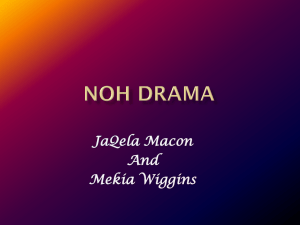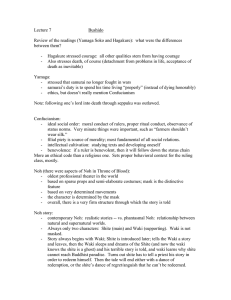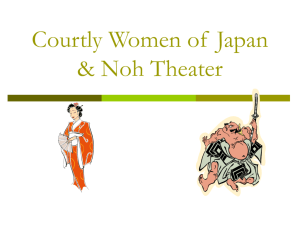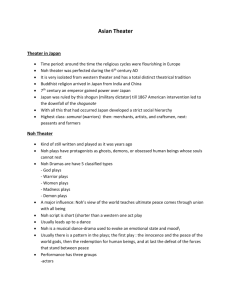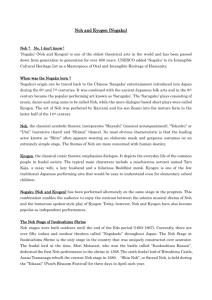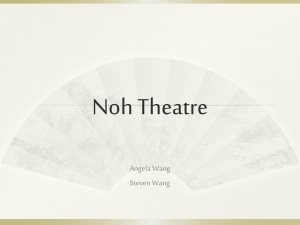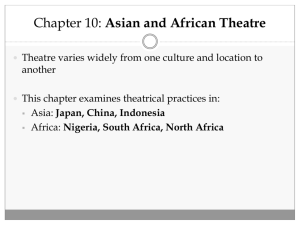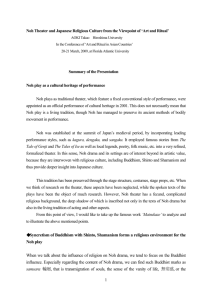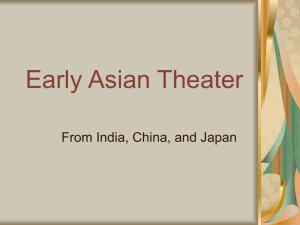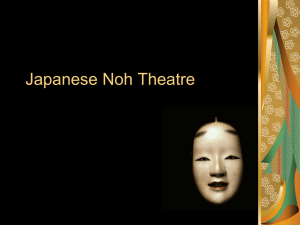HERE - Theatre History I: From Ritual to Renaissance
advertisement
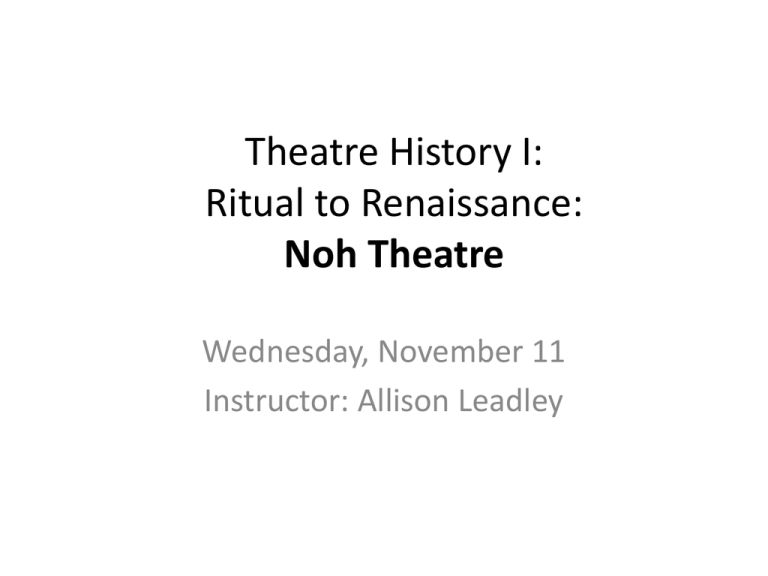
Theatre History I: Ritual to Renaissance: Noh Theatre Wednesday, November 11 Instructor: Allison Leadley Today’s Agenda • Review (Monday’s Class) • Noh Plays: Types and Structures • Staging Noh: The Noh Stage and Properties • Dōjōji (A Feminist Reading of a Noh Play) Review Question: What are some adjectives that you remember from the last lecture that are associated with Noh performance? Review: Noh’s Theatrical Predecessors - Shinto inspired forms of shamanistic ceremonies and dances - Masked dance dramas in the court - Travelling troupes (like that which Kan’ami originally belonged to) Review: The Influence of Chinese Culture? - Masked dance dramas in court (bugaku, gigaku) - Buddhism - Confucianism Review: The Influence of the Shogun? -Ashikaga Yoshimitsu -Kan’ami -Zeami Review: Noh’s Effects yugen or “mysterious beauty” – a mood of quietness, meditation, and aesthetic gratification ran-i or “the sublime” – a feeling of ecstasy and exaltation produced by exceptional artistry As the emphasis in Noh theatre is not on any unfolding action or suspense, Noh theatre is not grounded in intricate plotting but instead, exists to create mood, emotion, and a spiritual state Most plays are dominated by a single, powerful emotion summarized by the harmony of instrumental and vocal music, dance and gesture, and poetry Types of Noh Plays Noh plays are grouped into five categories according to subject matter 1. God plays celebrating an auspicious religious event 2. Warrior plays in which the protagonist is usually a slain warrior whose ghost returns to relieve human suffering 3. Woman plays (“wig plays” ) 4. “Living person pieces” which deal with madness, obsession, or unbridled passion 5. Demon plays Question: What “type” or category of play would you classify Dōjōji as? As the plays are quite short (and, as original performances would not have been as elongated as today) an evening of Noh theatre would have consisted of each of the five plays with one short comedic play (kyogen) performed in between each (Like satyr plays performed at the City Dionysia) Kyogen: Emphasizes comic inversions of social roles and stereotypical behavior Differences between Noh and Kyogen: Kyogen = No masks No chorus Reserves song and dance for comedic effect Scripts use a “brocade style” that weaves together well-known stories, poetry, and Buddhist references This can make it difficult to translate Noh Theatre for Western audiences (Greenwald likens this to a play that combines literary allusions to the bible, Shakespeare, and Arthurian legends) Characters in a Noh Play: The Shite and Waki The Shite: “the doer” – this character is the protagonist Waki: translates to “listener” or “sideman” (usually the first character to appear and establish the dramatic situation) Question: Who is the shite in Dōjōji? Who is the waki? Other Important Players The Chorus: 8 – 15 members -no particular identity (unlike Greeks) -can describe action or take on shite’s lines -(kneeling) to the audience’s right Question: How would you describe the function of the chorus in Dōjoji? Other Important Players The Musicians: play flute and drums, located upstage in front of the painted tree The Stage Assistants: Responsible for handling props, straightening costumes, or prompting actors. While visible to the audience, they are unobtrusive Question: How would you describe the role of the stage assistants in Dōjōji? Becoming the Character Monomanae -concept introduced by Zeami in his writings -Is not like Western mimesis -Western mimesis = imitation of an action (Aristotle) = representational -Zeami’s monomanae = non-representational = physical Becoming the Character: Acting Style The Noh acting style can be described as gestic Gender and class are defined not by realistic imitation, but by conventionalized gesture, movement, and costume Contemporary Gestic Performance? Other Gestic Elements in Noh? Elin Diamond Reads Brecht through feminist lens: alienation renders the social construction of gender apparent) -a single character performed by several actors -dialogue that cites other literary works -masks that do not fully hide the actor’s face -costumes that do not emphasize the actor’s gender, class, or physical body (Note, not to be confused with how costume symbolizes a character) Contemporary Gestic Theatre? The Noh Mask For Zeami, the mask allows the actor to become another character; his body body becomes a vessel inhabited by another “essence” which resides in the mask The Noh Mask Scholars estimate that there were originally about 60 different types of Noh masks; today, that number is approaching 200 Usually, it is only the shite who wears a mask Believed that they were introduced to enhance the yugen of performance – hide the unattractive aspects of the actors face to make the aesthetic beauty of Noh stronger A Selection of Noh Masks The Noh Mask However, the mask does not cover the actor’s face entirely – often, will see a bit of the actor’s own flesh Actor is to imbue the mask with emotion using subtle movements (tilting the head up or down) Manipulating the Noh Mask The Noh Stage -A raised wooden stage with a roof held up by four pillars -No special stage settings or lighting (only minimal stage properties) -Empty ceramic jars beneath stage floorboards to enhance the stomping of feet -Painted tree on the back wall representative of the “epiphany pine” – where a god-possessed priest once danced A bridge connects the stage with the curtained “mirror room” where the actors prepare; this bridge is also seen as a passage that connects this world to the spirit world The Noh Stage Dōjōji Question: Who can provide a summary of the play’s events? (To help you along, the characters): The abbot of Dōjōji Two priests of the temple Two temple servants A dancer (later, the serpent demon) Question: Were there any elements that felt “familiar”? There are a few characteristics of Dojoji that make it particularly memorable for scholars and audiences: 1. The hypnotic dance rambyōshi https://www.youtube.com/watch?v=MLu9927A8YQ 2. The large bell prop (and the risky stunt at the play’s climax) 3. The lack of clear resolution at the end How can we interpret this ambiguous ending… A Feminist Reading of Dōjōji “CASE STUDY: The silent bell: The Japanese nō play, Dōjōji” by Carol Fisher Sorgenfrei Sorgenfrei is a director, playwright, and scholar specializing in Japanese theatre and intercultural theatre Sorgenfrei on the ambiguous ending: -the climax is a cosmic battle between demonic female forces and holy, male forces -She connects this to the largely femalecentered religion of Shinto in comparison to the male-centered Buddhist religion Shinto and Female Sexuality • Author traces the origins of Noh to the shocking dance of Uzume, a female Shinto deity (dance to bring Amaterasu out of hiding) • She reads the myth through a feminist lens: -Amaterasu = female identified with the lifegiving sun, her “emotional” and “irrational” response to the bad behavior of an her unruly brother threatens to disrupt nature - Uzume = displays body in a divine striptease (but not for pleasure of male viewer, she is an active agent in her sexuality!) Amaterasu and Uzume’s sexuality is both powerful and dangerous (and both have great agency in how they use it!) Author argues that the play is designed to insight fear: like the demon lurking in the river to resurface at any time, Amaterasu and Uzume’s power (and, by extension) female sexuality can be contained but not destroyed A Warning to Rulers? Author also looks at the historical moment of the play text and notes that the position of aristocratic women were taking a distinct downward turn -Posits that this acts as a possible warning to rulers that chaos could erupt if rulers fail to guard against all those they had dispossessed Dōjōji Today? Sorgenfrei draws parallels between the Muromachi period (1336 – 1573) and late 20th and early 21st century Japan to account for the play’s popularity today: -Appear outwardly serene, smooth-running, and homogenous but filled with contradictions and turmoil: But what about Noh’s popularity outside of Japan? The Gull: The Stevenson Noh Project Einstein on the Beach (Robert Wilson and Philip Glass) At the Hawk’s Well (W. B. Yeats)
